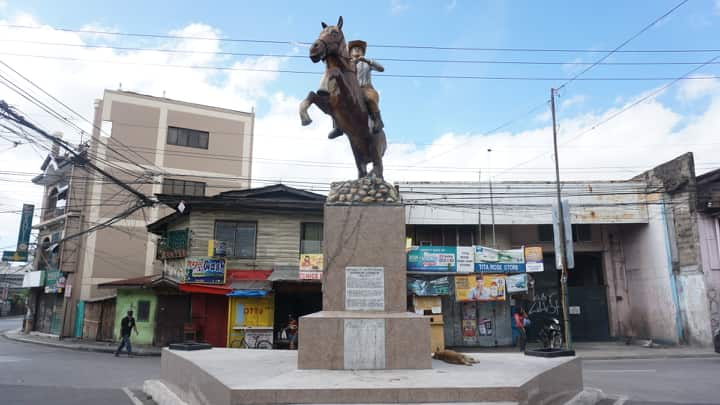CEBU CITY, Philippines – Today, April 3, on the anniversary of the Tres de Abril battle, Cebuanos gather to commemorate the historic event that marked a crucial moment in Philippine history.
On April 3, 1898, a small group of Sanicolanons, led by the legendary Leon Kilat, bravely rose against the Spanish oppression, which eventually sparked a courageous stand for freedom and independence.
The Tres de Abril Battle, even often overshadowed by larger historical events, has remained a testament to the resilience and bravery of the Filipino people.
The battle of Tres de Abril
As the sun rose over Cebu City on that fateful day, the streets echoed with the sounds of rebellion as Leon Kilat, whose real name is Pantaleon Villegas, and his comrades launched a daring assault on Fort San Pedro.
Despite facing overwhelming odds, the revolutionaries exhibited a steadfast resolve, with their hearts fueled by a burning desire for liberty.
READ MORE:
Guadalupe River cleanup pushed
Rama: Battle of Tres de Abril is a reminder of the Cebuanos freedom
The battle raged for hours, with both sides locked in a fierce struggle for control. The revolutionaries, armed with little more than courage and determination, fought valiantly against the well-equipped Spanish forces.
When the smoke cleared and the dust settled, the rebels emerged victorious, albeit briefly, as they managed to seize control of Fort San Pedro.
The streets of Cebu City erupted in jubilation as the people celebrated this symbolic win over oppression.
However, the joy was short-lived as Spanish reinforcements arrived from Manila. They quashed the rebellion and forced the revolutionaries into retreat.
Despite the setback, the spirit of resistance ignited by the Tres de Abril Battle continued to burn brightly, which inspired future generations to carry on the fight for freedom.
5 facts about the Tres de Abril battle
As we delve into the story of the Tres de Abril battle, let’s explore five fascinating facts about this historic event.
Leon Kilat was not a Cebuano
Contrary to popular belief, Leon Kilat hailed not from Cebu, but from Bacong, Negros Oriental.
While he earned his moniker for his swift prowess on the battlefield, his birth name was Pantaleon Villegas.
Before joining the Katipuneros, Kilat worked in Cebu, initially in a German-owned pharmacy. Later, he ventured to Manila, where he worked as an equestrian in a circus.
It was in the capital where he was recruited by the Katipunan, a revolutionary society established by anti-Spanish colonialism Filipinos in 1892.
Deeply devout, Kilat placed great faith in a talisman, purportedly rendering him impervious to bullets and a formidable opponent against Spanish firearms.
The revolution was done on a Palm Sunday, five days earlier than planned
The Tres de Abril battle unfolded unexpectedly on Palm Sunday, five days earlier than originally planned.
Leon Kilat’s initial strategy involved storming Fort San Pedro on April 6, Good Friday.
However, a resident of Pueblo San Nicolas inadvertently divulged the plans during confession, leading the friar to alert the Spanish authorities.
In a desperate bid to catch the Spaniards off guard, Kilat and his Cebuano warriors seized arms on April 3.
The revolution was successful for three days but…
Despite initial success, the Cebuano revolutionaries’ victory over Fort San Pedro was short-lived.
Their meticulous planning, including well-timed attacks during Spanish reloading, allowed them to control the fort for three days, bringing joy to the entire city.
However, four days later, on April 7, the Spanish armada arrived from Manila aboard Don Juan de Austria, providing much-needed supplies to the besieged Spanish troops. Kilat and his men were eventually driven out of Ciudad de Sugbo.
Leon Kilat died under the hands of Cebuanos
Tragically, Leon Kilat met his demise at the hands of Cebuanos on April 8, just five days after the Tres de Abril battle.
Seeking refuge in Pueblo Carcar, he was warmly welcomed by its residents, unaware of their loyalty to the Spanish.
That fateful night, Kilat was ruthlessly murdered, prematurely ending the revolution he had fervently fought for. He fell victim to the swords of his own people.
The revolution did not die with Leon Kilat
Despite Kilat’s untimely demise, the revolution against the Spaniards in Cebu persisted. Under the leadership of Cebuano General Arcadio Maxilom, Kilat’s men continued the fight, capturing the towns of Toledo and Balamban.
Though the Battle of Tres de Abril did not immediately oust the Spaniards, it ignited the revolutionary spirit among the Cebuanos. This historic event serves as a poignant reminder of their valiant struggle for freedom.
